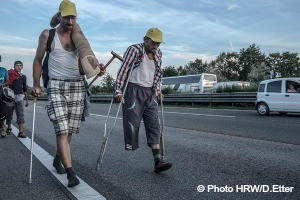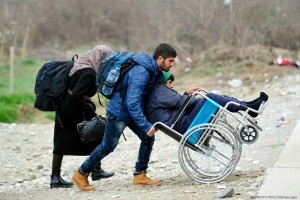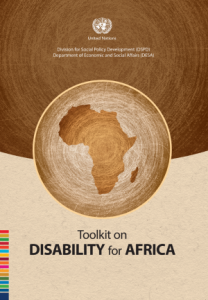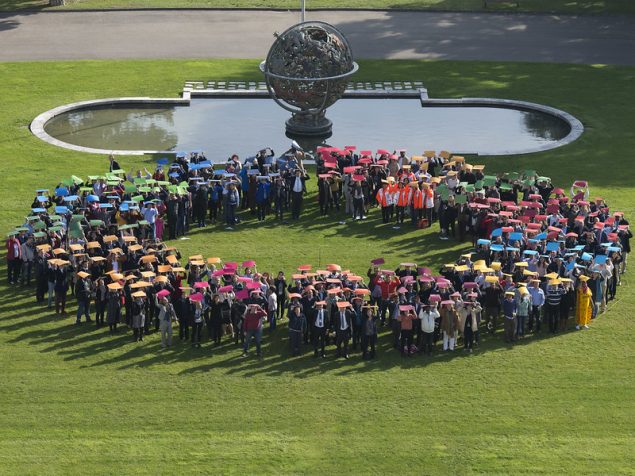
Status of refugees and migrants with disabilities
Migration and displacement are important issues for both human rights and development policy-makers and practitioners. By definition, migration refers to both voluntary movement (e.g. migrant workers) and involuntary movement (e.g. refugees) of women and men, across geographic borders internationally or internally, with the search for a better life (UNDP, 2016). According to estimates, the number of international migrants had reached 232 million globally in 2013 (UNDESA, Population Division, 2013); of the 59.5 million people forcibly displaced worldwide in 2014, about 19.5 million are refugees and 1.8 million were asylum seekers (UNHCR, 2014). Moreover, there is an overwhelming majority of people who migrate inside their own country, the number of which approaches to 740 million, almost four times as many as the international migrants (UNDP, 2009). With regards to disability, however, there is a lack of data regarding the situation and numbers of migrants with disabilities.
Migrant workers who migrate internally or international, move primarily in search of better economic opportunities and better access to education and health, which can improve the prospects of their children (UNDP, 2009). Studies suggest that migrant workers with lower skills or lower level of educational attainment are exposed to higher risk of acquiring a disability, as they are often assigned to dangerous manual labour resulting in a higher frequency of industrial accidents, such as construction and manufacturing workers. However, most of these low-skilled migrant workers are usually unable to access quality health services and social security including disability benefits, compared to the host population. Therefore, migrant workers with low skills are more vulnerable in the event of disability.
In the context of conflicts or natural disasters where people are displaced to flee insecurity and violence, the relation between disability and forced displacement is even more complicated. On one hand, disability may be a consequence of forced displacement; on the other hand, refugees with disabilities are more likely to be sidelined in every aspect of humanitarian assistance due to physical, environmental and societal barriers against accessing information, health and rehabilitation services and human rights protection (UNHCR, 2011). Furthermore, forced displacement also amplifies the risk experienced by refugees with disabilities in violence, including sexual and domestic abuse, exploitation by family members, discrimination and exclusion from access to education, livelihoods, a nationality and other public services.
Too often, States have addressed migration solely through the lens of sovereignty, border security or law enforcement, sometimes driven by hostile domestic constituencies. Oftentimes, States have legitimate interests in securing their borders and exercising immigration controls. Yet, such such concerns cannot, and indeed do not, trump the obligations of the State to respect the internationally guaranteed rights of all persons, to protect those rights against abuses, and to fulfill the rights necessary for them to enjoy a life of dignity and security. Protecting these rights is not only a legal obligation; it is also a matter of public interest and intrinsically linked to human development (Global Migration Group, 2010).
Invisibility of refugees and migrants with disabilities in the international normative framework
Although the international normative framework has broadly recognized the importance of addressing the needs of persons with disabilities in the fields of human rights and development, it has historically overlooked the subgroups within the disabled people in the context of migration, including migrant workers with disabilities and refugees with disabilities.
The World Programme of Action (1982) highlights the situation of displaced persons and calls for the removal of social and physical barriers which confront persons with disabilities among refugee populations. It also notes the additional burden of being a refugee and a person with a disability. The Standard Rules on the Equalization of Opportunities for Persons with Disabilities (1993) urges that the equalization of opportunities of refugees with disabilities should be integrated into general development programmes (Rule 21). The Convention on the Rights of the Persons with Disabilities (CRPD) in Article 18, calls upon States Parities to recognize the rights of persons with disabilities to liberty of movement, to freedom to choose their residence and to a nationality, on an equal basis with others; Article 11 specifically addresses protection of persons with disabilities in situations of risk, including armed conflict, humanitarian emergencies and the occurrence of natural disasters.
Currently, the international mandates on migrants have not yet directly integrated a disability dimension into the normative language. The International Convention on the Protection of the Rights of all Migrant Workers and Members of their families (ICRMW) recognizes the equal right of migrant workers to health and urges the States to ensure their access to both health and social services required for the prevention of irreparable harm to their health on the equal basis with others.
Moreover, the Secretary-General in his report (A/68/190) on international migration and development recommends that States need to tackle the challenge faced by migrants to access health care and to improve data on health conditions of migrants to inform effective policy-making.
In its conclusion No. 110 (LXI) adopted in 2010, the Office of the United Nations High Commissioner for Refugees (UNHCR, 2010) calls upon States and UN agencies to protect and assist refugees with disabilities against all forms of discrimination and to provide sustainable and appropriate support in addressing all their needs. Furthermore, in order to identify the protection and assistance needs, States, UNHCR and relevant partners should ensure a swift and systematic identification and registration of refugees and other persons with disabilities, with particular attention to those who cannot communicate their own needs. It is also encouraged to include refugees with disabilities in relevant policies and programmes in an accessible way.
The 2030 Development Agenda recognizes the importance of empowering people in vulnerable situations, including persons with disabilities, refugees and internally displaced persons. In particular, Goal 8 on decent work and economic growth includes a specific target to protect labour rights and promote safe and secure working environments for migrant workers. Goal 10 on reducing inequalities embraces two separate targets to empower persons with disabilities, and to facilitate orderly, safe, regular and responsible migration and mobility of people. As the global attention to the intersectionality issues has been increasing, it is essential to enhance the linkage between disability and migration in the future international dialogue.
Resources
- The Arab Forum For the Rights of Persons with Disabilities (AFRPD): Refugees With Disabilities Needs Assessment Report
- High-level Meeting at UN Headquarters to address large movements of refugees and migrants, UN Refugee Summit, 19 September 2016
- New York Declaration for Refugees and Migrants
- Side-event: Advancing the rights, well-being and perspectives of women and girls with disabilities in displacement through development and humanitarian responses, 16 September
- Secretary General’s report In Safety and Dignity: Addressing Large Movements of Refugees and Migrants
(Arabic, Chinese, English, French, Russian, Spanish) - International Convention on the Protection of the Rights of All Migrant Workers and Members of Their Families (Adopted by General Assembly resolution 45/158 of 18 December 1990)
- Report of the Secretary-General: International Migration and Development (A/68/190)
- UNDESA, Population Division, International Migration Report (2013)
- UNDP, Guidance Note: A Development Approach to Migration and Displacement (2016)
- UNDP, Human Development Report 2009, Overcoming barriers: Human mobility and development (2009)
- UNHCR, Facts and Figures about Refugees (2014)
- UNHCR, Unmet needs and diminished opportunities: disability, displacement and humanitarian healthcare (2011)
- UNHCR, Need to Know Guidance on Working with Persons with Disabilities in Forced Displacement (2011)
- UNHCR, Conclusion on refugees with disabilities and other persons with disabilities protected and assisted by UNHCR (2010)
- Global Migration Group on the Human Rights of Migrants in Irregular Situations (2010)
- Disability-inclusive Humanitarian Action
- Handicap International, Disabled and Alone, South Sudanese Refugee Finally Finds Safety
- Handicap International, Advocating For Disabled Refugees
- Women Refugee Commission, Refugees with Disabilities | Fact Sheet
- Women Refugee Commission, Disability Inclusion: Translating Policy into Practice in Humanitarian Action
- Forced Migration Review, Issue 35, 27 feature theme articles on Disability and Displacement
Be informed! Get involved! Please let us know if you have updates to the above information and/or additional resources that could help make this page more useful. Email us: enable@un.org




